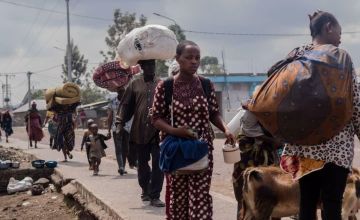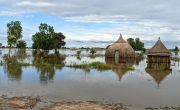
Knowledge Hub
Six humanitarian crises to watch out for in 2022

In 2022, 274 million people will need humanitarian assistance and protection. This number is a substantial increase from 235 million people a year ago, which was already the highest figure in decades. Here we put the spotlight on the global trends and humanitarian crises that are going to dominate in 2022.
Global trends
Covid-19

Covid-19 shows no signs of abating. So far, the virus has claimed at least 5.3 million lives worldwide, fuelled by variants and a lack of vaccines. Economies and livelihoods have been shattered, increasing humanitarian needs and fuelling conflict.
Only 7.5% of people in low-income countries have received at least one dose [OurWorldInData]. The rise in the number of people affected by Covid-19-induced poverty is expected to be between 119 and 124 million. For every three months that Covid-19 lockdowns continue, an additional 15 million GBV cases are expected to occur. The pandemic also continues to disrupt global education. School closures hit vulnerable children the hardest. Globally, 870 million students face disruptions to their education.
Read more about vaccine rollouts in Liberia and Sierra Leone.
Climate change
Climate-related disaster events are more frequent and variable than ever before. Up to 216 million people may have to move within their own countries by 2050 due to the effects of climate change.
COP26 – also called the ‘Crisis COP’ this year owing to urgent global action needed to limit global warming to 1.5 °C – took place in November 2021. However, its outcome was disappointing. What was clear is that the scale of the problem vastly outweighs the scale and pace of efforts that nations, especially the wealthier ones.
Across all the countries that Concern works in, we are seeing how the mounting effects of climate change are putting millions of lives at risk. Things must change in 2022.



Concern’s work on the ground with communities struggling to survive as climate change worsens involves a range of adaptation, resilience building and disaster risk management projects. From the construction of underground water tanks to harvest rain water, to the introduction of more drought-resistant plants and animals, and the construction of flood protection, these measures are enabling communities to adapt.
Conflict
In 2020, about 60% of all conflicts worldwide were violent. Despite repeated calls for global ceasefires due to the Covid-19 pandemic, political conflicts continue to hit civilian populations the hardest and further exacerbate the needs of the most vulnerable people. In April 2021, Secretary-General of the United Nations António Guterres called for a global ceasefire so that humanity could collectively address the Covid-19 pandemic. He did this because there were concerns that the outbreak could exacerbate existing divisions, or contribute to creating new conflicts. Conflict is the single biggest driver of humanitarian crisis today.
Hunger

Hunger is rising and food insecurity is at unprecedented levels. Globally, up to 811 million people are undernourished. Famine-like conditions remain a real and terrifying possibility in 43 countries around the world. In Afghanistan, more than half the population do not have enough to eat and 8.7 million people are on the brink of famine, suffering from very high rates of malnutrition. Over the coming winter months, temperatures in Afghanistan could drop to -25⁰C. With so many families on the brink of famine and children already dying, these freezing conditions will make matters worse. Over the next three months, the lives of a million more children under five are at risk of death.
Without sustained and immediate action, 2022 could be catastrophic.
Make a donation today to help provide the life-saving support that vulnerable families desperately need now.
Displacement
More than 1% of the world’s population is now displaced, about 42% of whom are children. Millions of IDPs are living in protracted situations, 40% fewer are able to return home.
The number of refugees remains at a record high, growing from 26.0 million in 2019 to 26.4 million at the end of 2020. Almost 65% of all refugees come from just five countries: Afghanistan, DRC, Myanmar, South Sudan and Syria. Developing countries host 83% of refugees, while the least developed countries have provided asylum to 33% of this total. Of these refugees, at least 40% are children and 49% women and girls.
Gender Inequalities
Gender inequality is the most common form of inequality across the globe. It is also one of the biggest barriers to ending extreme poverty.
According the United Nation’s new global analysis of progress on gender equality and women’s rights, women and girls remain disproportionately affected by the socioeconomic fallout from the Covid-19 pandemic, struggling with disproportionately high job and livelihood losses, education disruptions and increased burdens of unpaid care work. Women’s health services, poorly funded even before the pandemic, faced major disruptions, undermining women’s sexual and reproductive health. And despite women’s central role in responding to Covid-19, including as front-line health workers, they are still largely bypassed for leadership positions they deserve.
The pandemic has tested and even reversed progress in expanding women’s rights and opportunities. However, this can change. Bold actions and increased financing are needed to rebuild better and equal, to address the needs of all women and girls and leave no one behind.
Sign up to receive thought-provoking emails and invites to events where you will hear from women on the ground at the forefront of creating change.
What we’re doing to help
We deliver life-saving and life-changing interventions to some of the world's poorest and most vulnerable people. From rapid emergency response to our innovative programming in health and nutrition, livelihoods and education, we go to the hardest to reach places to make sure that no-one is left behind.
Other ways to help
Donate now
Give a one-off, or a monthly, donation today.
Join an event
From mountain trekking to marathon running, join us for one of our many exciting outdoor events!
Buy a gift
With an extensive range of alternative gifts, we have something to suit everybody.
Leave a gift in your will
Leave the world a better place with a life-changing legacy.
Become a corporate supporter
We partner with a range of organisations that share our passion and the results have been fantastic.
Create your own fundraising event
Raise money for Concern by organising your own charity fundraising event.





